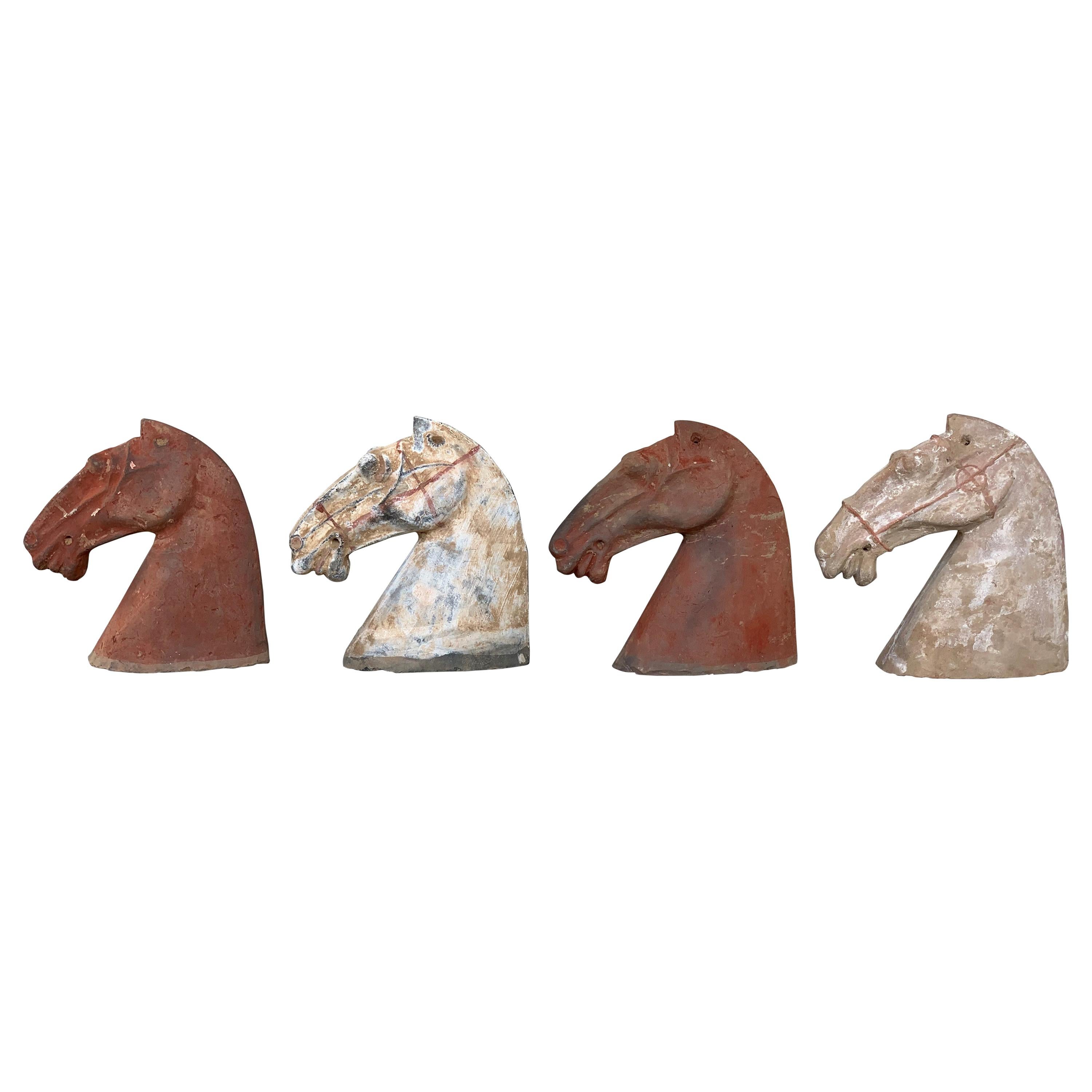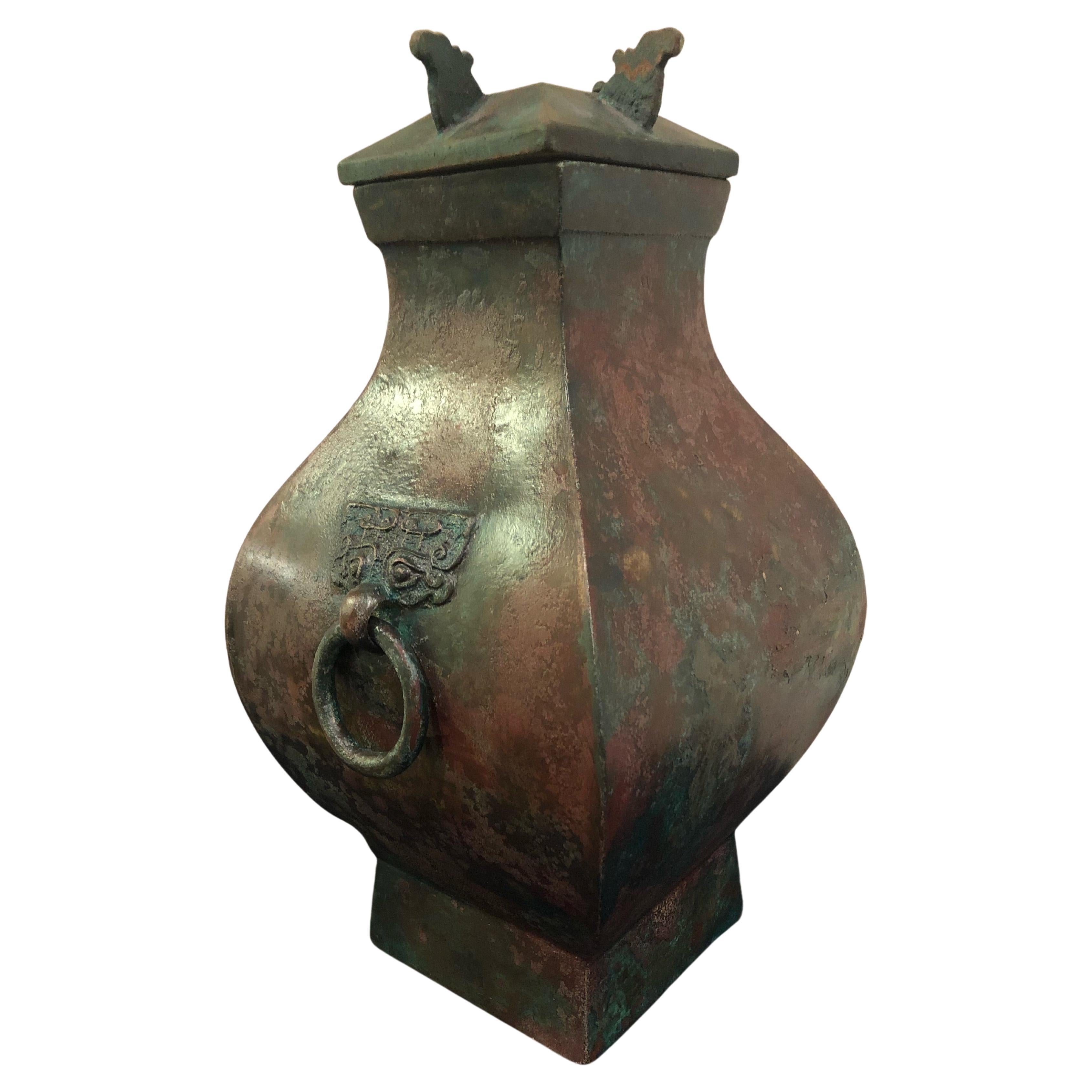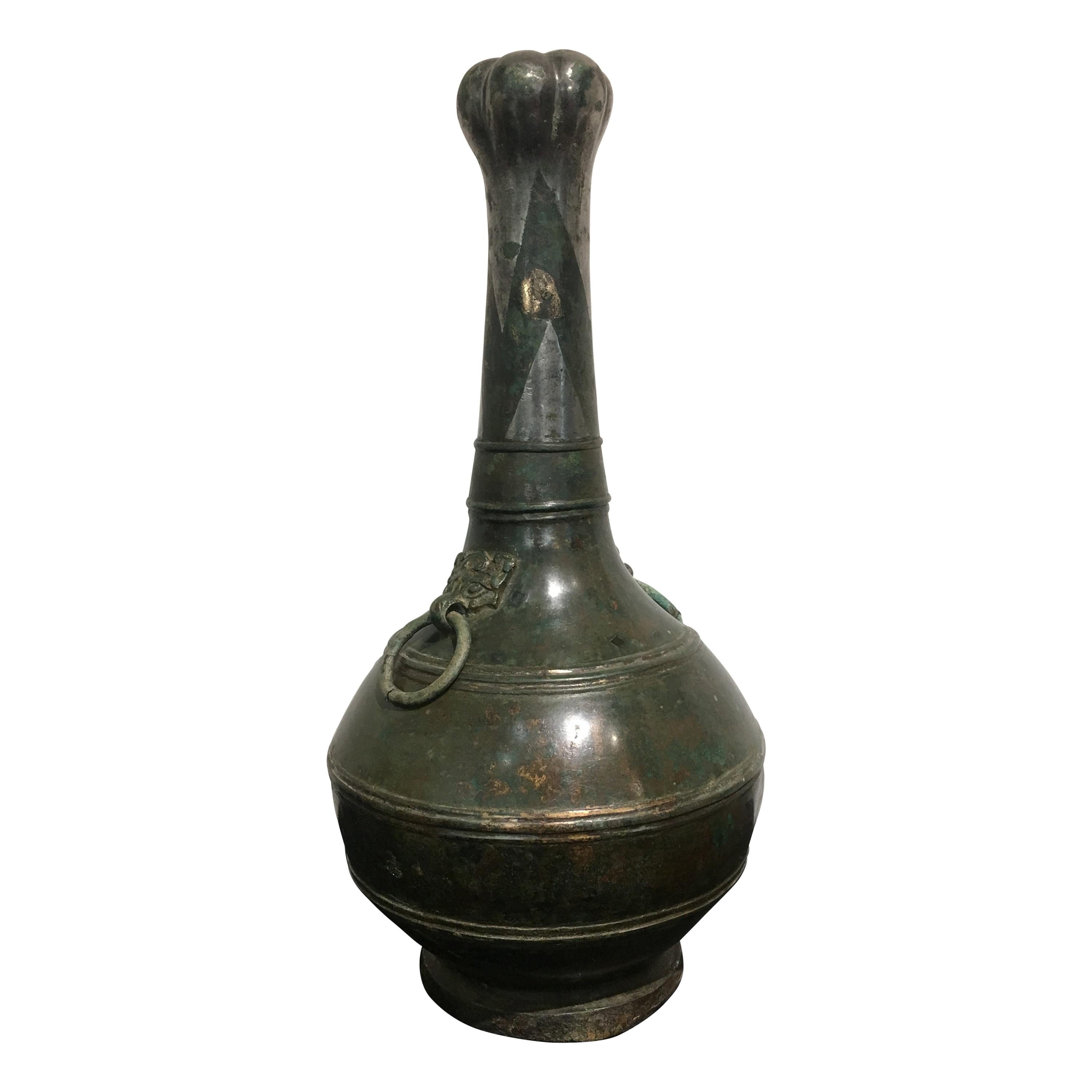Items Similar to Fanghu Han Dynasty 206BC-220AD Chinese Bronze Ritual Wine Vessel Jug & Cover
Want more images or videos?
Request additional images or videos from the seller
1 of 16
Fanghu Han Dynasty 206BC-220AD Chinese Bronze Ritual Wine Vessel Jug & Cover
About the Item
We are delighted to offer for sale this exceptionally important and highly collectable museum quality original Chinese bronze ritual wine vessel and cover, Fanghu Han Dynasty 206BC-220AD with Taotie mask handles - olive green and russet patina with specks of malachite encrustation
The quadrangular wine jar is raised on a high pyramidal foot. Two sides of the vessel are embellished with a crisply cast taotie-mask, through the nose of which a movable ring is placed. The mouth rim is accentuated with a narrow raised band. The square cover has a flat top and each side is applied with a bird-form finial that convert to supports when the cover is inverted. The vase has an attractive olive-green and russet patina and has some bright specks of malachite encrustation. The patina and encrustation enhance the beauty of the vase and make it interesting to look at: each side has its own appearance.
The taotie-mask is one of the most distinctive and characteristic images in Chinese art, originating from Shang ritual bronzes and becoming a much-used decoration in later dynasties: not only in bronze but also on other art-forms such as porcelain. The primary attribute of this frontal animal-like mask is a prominent pair of eyes, often protruding in high relief. Between the eyes is a nose, often with nostrils at the base. Taotie can also include jaws and fangs, horns, ears, and eyebrows. Many versions include a split animal-like body with legs and tail, each flank shown in profile on either side of the mask. While following a general form, the appearance and specific components of taotie masks varied by period and place of production. Is is thought that the taotie is a protective symbol. It is likely that the present fanghu is applied with these masks to protect the deceased in his grave and on his journey to the spirit world.
In terms of the condition its exactly as you would expect to find a piece 1800-2200 years old that has spent hundreds of years buried, there is one small loss to the top, otherwise it is a sublime museum quality example
Dimensions:
Height 35cm
Width 18.5cm
Depth 19.5cm
Please note all measurements are taken at the widest point
Chinese bronzes
In China bronzes first appeared in the Erlitou Culture (circa 2100-1600 BC), mainly in the form of libation vessels, jue, yet in the glorious days of the Bronze Age, during the Shang (circa 1700-1050 BC) and Zhou (1050-221 BC) dynasties, the quality of the casting of bronze was at its height. Not only bronze weapons were made with which the Shang and Zhou controlled peoples around them, but also much attention was paid by casters and their patrons to vessels in which food and wine were offered to ancestors. Most of these bronzes may be described as ritual vessels intended for the worship of ancestors, who are often named in inscriptions on the bronzes. These ritual vessels of ancient China represent possibly the most remarkable achievement in the whole history of metalcraft before modern times.
Bronze vases should not be considered individually but in groups as ritual sets. These sets are defined as the range of vessel types required for the correct performance of rituals. The combination of these vessels can be inferred from two sources, intact tomb groups and vessels that share a common dedication. From the arrangement and quantity of bronzes displayed in a given ceremony, one can discern the specific social status and position of that noble host. In the case of vessels interred in tombs it seems likely that the occupant of the tomb was expected to continue to offer sacrifices to his ancestors after his death and that vessels were buried for this purpose, even though he had become an ancestor himself. It is also possible that they were used at funerary rites. Besides their use in ancestral worship, rites of spirit worship and as symbols of status and power, bronzes could, it was believed, when buried with the deceased, continue to serve in the afterlife. As some aristocrats and all commoners at the time could not afford the expense of bronzes, frequently complete sets of ritual vessels were made in fired pottery.
In the Shang dynasty (circa 1600–1046 BC), the right to cast or possess these vessels was probably confined to the royal house itself but later was bestowed upon local governors set up by the ruler; still later, in the Zhou dynasty (1045–256 BC), the right was claimed by rulers of the feudal states and indeed by anyone who was rich and powerful enough to cast his own vessels. Under the ultimate unification of Qin and Han, Chinese bronzes gradually yielded its central role in the ritual system but transformed into a cultural archetype.
Shapes
Although there are many different shapes in Chinese bronze ritual vessels, they can be reduced to a few essential types used for the ritual of ancestor worship. Vessels were required in which to cook and serve the dishes, to preserve and hold the wine for drinking, and to contain and pour water. They can most simply be grouped according to their use in sacrifices.
Hu: A round-bellied vase or a jar with a cover
You: A ritual wine vessel with a stout oval body and an overhead handle, usually with a cover
Zun: Another ritual wine vessel, flared and with a bulbous mid-section
Gu: Also a ritual wine vessel, similar to the zun but with a slender silhouette
Jue: One of the more striking vessels of the archaic ritual bronze assembly — another ritual wine vessel, with a prominent spout, whorl-capped posts, flared tail and long tripod legs
Ding: A ritual cooking vessel with a globular body, tripod legs and a pair of upright handles
Gui: A ritual food vessel with a compressed globular body, raised on a waisted foot, with a pair of loop handles usually decorated with animal heads Square forms: Many of the standard shapes also appear in ‘square’ or fang versions, including the fangzun, fanghu and fangding. Of great significance to the ancient ruling elites, square vessels are much more rare. Square-sectioned vessels have a more formal and regular appearance.
Today, we see the Chinese bronzes in a very different condition from the original. Their long period underground has covered them with a patina, sometimes rough with encrustations and sometimes smooth like jade. They take on all the shades of green. Often, there are russet, purple or blue patches depending on the chemical changes which affected the metal. These alterations only emphasise the beauty of these bronzes.
This item is available for collection from our Wimbledon warehouses
Condition:
Please view the very detailed pictures as they form part of the description around condition
Please note vintage period and original items such as leather seating will always have natural patina in the form of cracking creasing and wear, we recommend regular waxing to ensure no moisture is lost, also hand dyed leather is not recommended to sit in direct sunlight for prolonged periods of time as it will dry out and fade.
- Dimensions:Height: 13.78 in (35 cm)Width: 7.29 in (18.5 cm)Depth: 7.68 in (19.5 cm)
- Style:Han (Of the Period)
- Materials and Techniques:
- Place of Origin:
- Period:
- Date of Manufacture:206BC-220AD
- Condition:Wear consistent with age and use. Minor losses. Minor structural damages. Minor fading.
- Seller Location:GB
- Reference Number:1stDibs: LU2823319780322
About the Seller
4.6
Platinum Seller
These expertly vetted sellers are 1stDibs' most experienced sellers and are rated highest by our customers.
Established in 2012
1stDibs seller since 2017
1,709 sales on 1stDibs
Typical response time: <1 hour
- ShippingRetrieving quote...Ships From: United Kingdom
- Return PolicyA return for this item may be initiated within 14 days of delivery.
More From This SellerView All
- HUGE ANTIQUE CHiNESE QING DYNASTY RICE BASKET WITH METAL SUPPORTS FRUIT BOWLLocated in GBRoyal House Antiques Royal House Antiques is delighted to offer for sale this huge Qing Dynasty Rice Basket with metal braces that can be used as a very large fruit bowl A good loo...Category
Antique 19th Century Chinese Qing Antiquities
MaterialsWood
- Very Rare 19th Century Hand Carved Qing Dynasty Chinese Hongmu Jardinière StandLocated in GBWe are delighted to offer for sale this stunning and very rare 19th century hand carved Chinese Qing Dynasty Hongmu stand A very good looking well mad...Category
Antique 19th Century Chinese Qing Planters, Cachepots and Jardinières
MaterialsWood
- STUNNING CHINESE EXPORT HAND CARVED WOOD DRAGON MANTLE CLOCK & CANDLESTiCKSLocated in GBRoyal House Antiques Royal House Antiques is delighted to offer for sale this stunning circa 1880-1920 Chinese Export hand carved dragon mantle clock with matching candlesticks A good looking and expertly carved suite...Category
Antique 19th Century Chinese Chinese Export Mantel Clocks
MaterialsWood
- Stunning Original Chinese circa 1900-1920 Mahjong Set Including CountersLocated in GBWe are delighted to offer for sale this lovely original circa 1900-1920 Chinese Mah-jong set which is totally complete with original counters The condition is very good for the age, I can’t fault it, naturally the case has patina marks Dimensions Height:- 14cm Width:- 27cm Depth:- 17.5cm Please note all measurements are taken at the widest point. This item is available for collection from our Pulborough warehouses RH20 1DF. We are privately owned family ran business founded in Wimbledon SW19 and now based in Pulborough RH20. We specialise in finding, restoring very fine luxury antique leather seating, along with every single other type of antique ranging from the 16th century to the 20th century. We also stock a number of designer brands such as Fritz Hansen, Ralph Lauren, Cavalli, Charles & Ray Eames, Vitra, David Linley, Rolex, Tiffany, Jager Le Coulter...Category
Antique Early 1900s Chinese Edwardian Games
MaterialsBamboo
- Pair of 1930s Vintage Bronze Jug Vase Urns with Little Cherub Angles Nice FindLocated in GBWe are delighted to offer for sale this lovely original pair of 1930s bronze jug vases with cherubs A good looking and well made pair, the Cherubs have t...Category
Early 20th Century Chinese Chinese Export Vases
MaterialsBronze
- Antique Liberty's London Art Nouveau Style Chinese Export Mahjong Complete SetBy Liberty of LondonLocated in GBWe are delighted to offer for sale this lovely original circa 1920 Chinese Mah-jong set which is totally complete with original counters, the case having a super rare Art Nouveau Lib...Category
Vintage 1920s Chinese Art Nouveau Antiquities
MaterialsWood, Bamboo
You May Also Like
- Pair of Han Dynasty Horse Heads (206BC - 220AD) AttributedLocated in Dallas, TXPair of Chinese Han dynasty horse heads Han dynasty (206 BC-220 AD) earthenware gray pottery Each approx.: 6.25 inches high. 6.5 inches wide. 2...Category
Antique 15th Century and Earlier Chinese Han Animal Sculptures
MaterialsPottery
- Pair of Red Sculpture Han Dynasty Gray Pottery Horse Heads '206BC-220AD'Located in Miami, FLPair of Chinese Han dynasty horse heads Han dynasty Style (206 BC-220 AD) earthenware gray pottery Each approximate measures: 6 inches high. 6...Category
Mid-20th Century Chinese Han Sculptures and Carvings
MaterialsTerracotta
- Massive Chinese Eastern Han Dynasty Impressed Pottery Jar '25-220 AD'Located in Austin, TXA stunning and massive Chinese high fired gray pottery jar of remarkable size and girth, with impressed geometric design, Eastern Han Dynasty (25-220 AD), ...Category
Antique 15th Century and Earlier Chinese Han Antiquities
MaterialsPottery
- Han Dynasty Horse Sculpture, 206BC- 209 ADLocated in Tunbridge Wells, GBHan Dynasty Horse Sculpture, 206BC- 209 AD It is interetsing to note the position of the riders feet. They are gripping the shoulder of the horse. D...Category
Antique 15th Century and Earlier Chinese Han Animal Sculptures
MaterialsPottery
- Early Bronze Fang Hu Ritual Wine Vessel Han DynastyLocated in Hopewell, NJVery early, 206 BC to 220 AD, square shaped bronze fang hu bronze vessel would have functioned as a ritual container for the storage and transportation of sumptuous wines. This refin...Category
Antique 15th Century and Earlier Chinese Han Bottles
MaterialsBronze
- Chinese Han Dynasty Silver-Decorated Garlic Head Bronze Hu Vase, 3rd Century BCLocated in Austin, TXA gorgeous and striking late Warring States (475 to 221 BC) or early Han Dynasty (221 to 206 BC) cast bronze and silver-decorated garlic head hu vessel. Of elegant bottle form, w...Category
Antique 15th Century and Earlier Chinese Han Antiquities
MaterialsBronze
Recently Viewed
View AllMore Ways To Browse
Chineses Bronze
Chinese Bronzes
China Bronze
Chinese Bronze
Chinese Bronze Antique
Chinese Antique Bronze
Antique Chinese Bronze
Antique Chinese Bronzes
Ancient Antiquities
Art And Bronze And Round
Antique And Vintage Furniture Wimbledon
Wine Vintage Art
Antique Wine Art
Wine Cover
Blue China Items
Asian Finials
Vessel Jug
Chinese General





